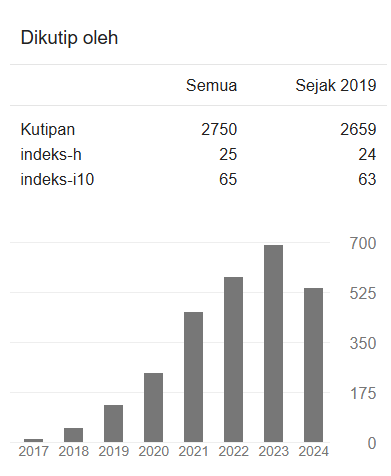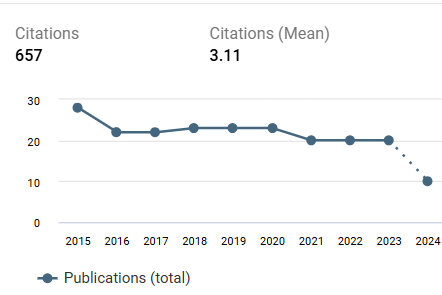Penggunaan lembar kerja berciri representasi matematis: uji pengaruh terhadap kemampuan rekognisi simbol matematika
DOI:
https://doi.org/10.22219/jinop.v7i2.13325Keywords:
Worksheets, representations, symbol recognitionAbstract
Mathematical representation is one of the mathematical recognition’s form. This study aimed to compare the ability of students' mathematical symbol recognition between learning using Student Activity Sheets characterized by mathematical representation and learning using group presentation assignment activities. The research method employed Posttest-Only Control Group Design, between the control class and the experimental class. The control class is a class with group presentation learning assignments while the experimental class is a class with learning that uses MFIs characterized by mathematical representations. The data were obtained by providing tests to measure students' mathematical recognition abilities. The data were analyzed by using the t-test. The results of calculations with the help of SPSS showed that data from both classes are normally distributed and homogeneous. The results of data analysis conducted by t-test showed sig. ≥0.05 so H1 is rejected and H0 is accepted which means that there was no difference in the ability to recognize mathematical symbols between the control class and the experimental class. There was no difference in recognition abilities between the control class and the experimental class because learning activities in both classes are student-centered learning.
Downloads
References
Al-Ayyubi, I. I., Nudin, E., & Bernard, M. (2018). Pengaruh Pembelajaran Berbasis Masalah terhadap Kemampuan Pemecahan Masalah Matematis Siswa SMA. JPMI (Jurnal Pembelajaran Matematika Inovatif), 1(3), 355–360.
Aliyanti, A. P., Putri, O. R. U., & Zukhrufurrohmah, Z. (2019). Analisis Kesalahan Representasi Simbolik Mahasiswa dalam Menyelesaikan Soal High Order Thinking Skill. Aksioma: Jurnal Program Studi Pendidikan Matematika, 8(3), 382–394.
Astuti, E. P. (2017). Representasi matematis mahasiswa calon guru dalam menyelesaikan masalah matematika. Beta: Jurnal Tadris Matematika, 10(1), 70–82.
Atsnan, M. F., Gazali, R. Y., & Nareki, M. L. (2018). Pengaruh pendekatan problem solving terhadap kemampuan representasi dan literasi matematis siswa. Jurnal Riset Pendidikan Matematika, 5(2), 135–146.
Daniel, F., & Taneo, P. N. L. (2019). Pengembangan Buku Ajar Teori Graf untuk Meningkatkan Kemampuan Representasi Matematis Siswa pada Mata Kuliah Matematika Diskrit Development of Graph Theory Textbooks to Improve Students ’ Mathematical Representation Ability in Discrete Mathematics Subject. Edumatica Jurnal Pendidikan Matematika, 09(22).
Diani, R. (2016). Pengaruh pendekatan saintifik berbantukan LKS terhadap hasil belajar fisika peserta didik Kelas XI SMA Perintis 1 Bandar Lampung. Jurnal Ilmiah Pendidikan Fisika Al-Biruni, 5(1), 83–93.
Fannie, R. D., & Rohati, R. (2014). Pengembangan lembar kerja siswa (LKS) berbasis POE (predict, observe, explain) pada materi program linear kelas XII SMA. Sainmatika: Jurnal Sains Dan Matematika Universitas Jambi, 8(1).
Fonna, M., & Mursalin, M. (2018). Pengembangan Modul Geometri Analitik Bidang Berbantuan Wingeom Software untuk Meningkatkan Kemampuan Representasi Matematis Mahasiswa Program Studi Pendidikan Matematika Universitas Malikussaleh. Proceeding Seminar Nasional Politeknik Negeri Lhokseumawe, 1(1), 1–6.
Gordah, E. K., & Fadillah, S. (2014). Pengaruh Penggunaan Bahan Ajar Kalkulus Diferensial Berbasis Pendekatan Open Ended Terhadap Kemampuan Representasi Matematis Mahasiswa. Jurnal Pendidikan Dan Kebudayaan, 20(3), 340–352.
Hernawati, F. (2016). Pengembangan perangkat pembelajaran matematika dengan pendekatan PMRI berorientasi pada kemampuan representasi matematis. Jurnal Riset Pendidikan Matematika, 3(1), 34–44.
Hutagaol, K. (2013). Pembelajaran kontekstual untuk meningkatkan kemampuan representasi matematis siswa sekolah menengah pertama. Infinity Journal, 2(1), 85–99.
Jeheman, A. A., Gunur, B., & Jelatu, S. (2019). Pengaruh Pendekatan Matematika Realistik terhadap Pemahaman Konsep Matematika Siswa. Mosharafa: Jurnal Pendidikan Matematika, 8(2), 191–202.
Khairunnisa, G. F., As’ari, A. R., & Susanto, H. (2018). Keberhasilan Siswa dalam Menyelesaikan Soal Cerita Berdasarkan Kemampuan Membuat Berbagai Representasi Matematis. Jurnal Pendidikan: Teori, Penelitian, Dan Pengembangan, 3(6), 723–730.
Laili, Y. N., Mahardika, I. K., & Ghani, A. A. (2015). Pengaruh model children learning in science (CLIS) disertai LKS berbasis multirepresentasi terhadap aktivitas belajar siswa dan hasil belajar siswa dalam pembelajaran fisika di SMA Kabupaten Jember. Jurnal Pembelajaran Fisika, 4(2).
Laurens, T., Batlolona, F.A., Batlolona, J.R., Leasa, M. (2017). How does realistic mathematics education (RME) improve students' mathematics cognitive achievement?. Eurasia Journal of Mathematics, Science and Technology Education, 14(2), 569-578.
Listiani, I. (2018). Efektivitas Lembar Kerja Untuk. Jurnal Penelitian Pendidikan, 35(I), 17–26.
Mairing, J. P., & Lorida, D. (2013). Pengembangan Lembar Kerja Mahasiswa Berbasis Masalah dan Proyek pada Matakuliah Analisis Data. Jurnal Pendidikan, 14(2), 53–61.
Malviya, S. (2019). Symbol as Metonymy and Metaphor: A Sociological Perspective on Mathematical Symbolism. Science, Technology and Society, 24(1), 53–72.
Mandasari, N. (2018). Elaborasi Kognitif dalam Proses Abstraksi Konsep Matematika. Prosiding Seminar Nasional Program Pascasarjana Universitas PGRI Palembang, 5(05).
Murni A., Anggraini, R.D., & Sakur. (2018). The development of student worksheets based on metacognitive approach to improve students’ mathematical representation ability. Journal of Physics: Conf. Series 1088.
Noer, S. H., & Gunowibowo, P. (2018). Efektivitas Problem Based Learning ditinjau dari Kemampuan berpikir kritis dan representasi Matematis. JPPM (Jurnal Penelitian Dan Pembelajaran Matematika), 11(2).
Nursanti, R. (2019). Improving Mathematical Representation Ability Through Student Worksheets: a Contextual Approach on Relation and Function Discussion. Jurnal Pendidikan Matematika dan IPA, 10(2), 284-298.
Presmeg, N. C. (2013). Reasoning with metaphors and metonymies in mathematics learning. In Mathematical reasoning (pp. 275–288). Routledge.
Sabirin, M. (2014). Representasi dalam Pembelajaran Matematika. Jurnal Pendidikan Matematika, 1(2), 33. https://doi.org/10.18592/jpm.v1i2.49
Sembiring, R. K. (2010). Pendidikan Matematika Realistik Indonesia (PMRI): Perkembangan dan Tantangannya. Journal on Mathematics Education, 1(1), 11–16.
Septian, A., Darhim, & Prabawanto, S. (2020). Mathematical Representation Ability Through Geogebra-Assisted Project-Based Learning Models, Journal of Physics, 1-10.
Supriadi, et al. (2018). The Utilization of Project Based Learning and Guided Discovery Learning: Effective Methods to Improve Students’ Mathematics Ability, Al Ta'lim Journal, 25(3).
Syafri, F. S. (2017). Kemampuan Representasi Matematis dan Kemampuan Pembuktian Matematika. JURNAL E-DuMath, 3(1).
Utami, S. D., Asnawati, R., & Coesamin, M. (2015). Efektivitas Penerapan Problem Based Learning ditinjau dari Kemampuan Representasi Matematis. Jurnal Pendidikan Matematika Unila, 3(5).
Widakdo, W.A. (2017). Mathematical Representation Ability by Using Project Based Learning on the Topic of Statistics, Journal of Physics, 1-7.
Zukhrufurrohmah, Z., & Kusumawardana, A. S. (2019). Analisis kesalahan matematis mahasiswa teknik sipil pada mata kuliah kalkulus II. Jurnal Review Pembelajaran Matematika, 4(1), 1–10.
Downloads
Published
How to Cite
Issue
Section
License
Copyright (c) 2021 Zukhrufurrohmah et al

This work is licensed under a Creative Commons Attribution 4.0 International License.
Copyright Notice
Authors who publish with JINoP (Jurnal Inoasi Pembelajaran) agree to the following terms:
- For all articles published in the JINoP (Jurnal Inovasi Pembelajaran), copyright is retained by the authors. Authors give permission to the publisher to announce the work with conditions. When the manuscript is accepted for publication, the authors agree to the automatic transfer of the publishing right to the publisher.
- Authors retain copyright and grant the journal the right of first publication with the work simultaneously licensed under a Creative Commons Attribution 4.0 International License. that allows others to share the work with an acknowledgment of the work's authorship and initial publication in this journal.
- Authors are able to enter into separate, additional contractual arrangements for the non-exclusive distribution of the journal's published version of the work (e.g., post it to an institutional repository or publish it in a book), with an acknowledgment of its initial publication in this journal.
- Authors are permitted and encouraged to post their work online (e.g., in institutional repositories or on their website) prior to and during the submission process, as it can lead to productive exchanges, as well as earlier and greater citation of published work (See The Effect of Open Access).








